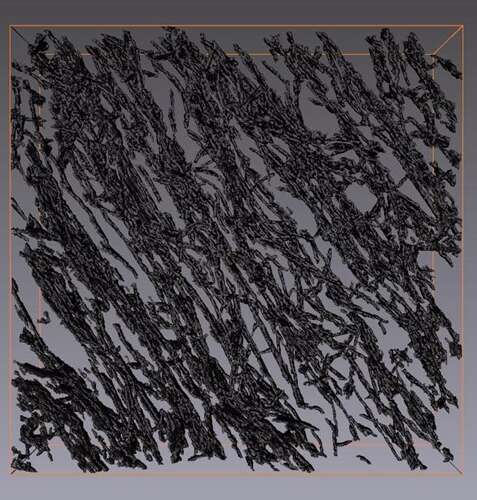
3D TRANSMISSION ELECTRON MICROSCOPY TO UNDERSTAND MORPHOLOGY-PERFORMANCE CORRELATIONS OF ALIGNED NANOFIBER NANOCOMPOSITES
2Center for Nanoscale Science and Technology, National Institute of Standards and Technology, Gaithersburg, Maryland
3Department of Mechanical Engineering, Massachusetts Institute of Technology, Cambridge, Massachusetts
Polymer nanocomposites (PNC) based on aligned carbon nanotubes (A-CNT) are considered next-generation advanced materials with wide-ranging applications. The enticing scale-dependent and intrinsic properties of CNTs, together with the ability to transfer them anisotropically to the PNC, create unique possibilities for fabrication and improvement of the material properties. However, the said properties, as measured experimentally, fall short of the theoretical predictions – suggesting that the true PNC structure is different than assumed in the predictions.
The nanoscale morphology of PNC containing high volume fraction (Vf) of A-CNT is presented here in 3D, using electron tomography. Energy filtering is shown to effectively enhance the challenging contrast of carbon-in-carbon hybrids. Using a novel automated segmentation method, we visualize the CNT arrangement fast and accurately. Further, we quantify the effect of Vf on the CNT morphology and dispersion, creating rich data on the evolution of network structure, bundling, alignment and waviness. This data reveals a nonlinear increase in bundling and alignment and reduced waviness with increasing A-CNT Vf.
Such new understanding of the nanoscale structure of the embedded A-CNT is then used to explain trends in properties enhancements with respect to Vf. Experimental data (thermal, electrical and mechanical properties) already in literature is re-visited to better understand previously puzzling results e.g. large and non-linear increase in thermal conductivity with increasing Vf is found to be with correlated with increased bundling and alignment.
The results presented here show the power of electron tomography in the study of 3D nanoscale morphology of composites, as well as its necessity in optimizing the design of smart, hierarchical composites.

Powered by Eventact EMS